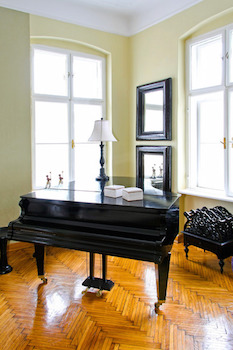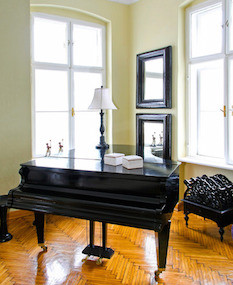Have you ever listened to a piano in a grand concert hall, impressed with its overall sound? Then you return to your home, play the same song, and wonder what happened to the quality of the music?
Your piano’s tone depends on a variety of things. A piano will have a bright tone if it has many upper partials; a subdued tone if it lacks. If it is placed on a hard surface, it will reflect the sound; a soft surface will absorb it.
Just by changing the position and location of your piano, you can adjust the sound your piano produces. Hardwood floors, tile floors, carpeting, high ceilings, hard walls, glass windows, upholstered furniture, drapery, even people will all change the acoustical conditions of the room, and thus impact the sound being produced.
If you prefer a bright sound, a room with hard surfaces will help you create an incisive sound. If you prefer a more subdued tone, add softer elements to help absorb the sound.
For a bright tone:
- Open the lid of your grand piano. The strings will reflect the sound outward, and amplify it into the room. The lid should open into the room, not into a wall.
- Draperies should be kept at a minimum. If you choose to cover your windows, choose freeflowing, unlined drapery that will help produce a richer sound. One caveat: if your room has lots of windows, make sure sunlight doesn’t stream onto the piano, which can cause it to go out of tune in a much faster timeframe.
- Use light fabrics for your decorating. Avoid velvets and brocades and choose cottons and satins instead.
- Replace carpeting with wood or tile.
- Remove acoustical or textured ceilings.
For a subdued tone:
- Close the lid on the grand piano, or use the half stick.
- Use acrylic caster cups on the piano legs to isolate the piano from the flooring, to prevent the floor from acting as a soundboard.
- Use soft wall treatments, such as cork, and make sure all doors and windows are properly sealed.
- Use heavier drapery.
- Select heavier upholstered furniture.
- Install wall to wall carpeting.
When you work to change the tone being produced by your piano, don’t forget to have a technician voice your piano when your redesign is completed. A revoicing will help further create the tone you are looking for.


